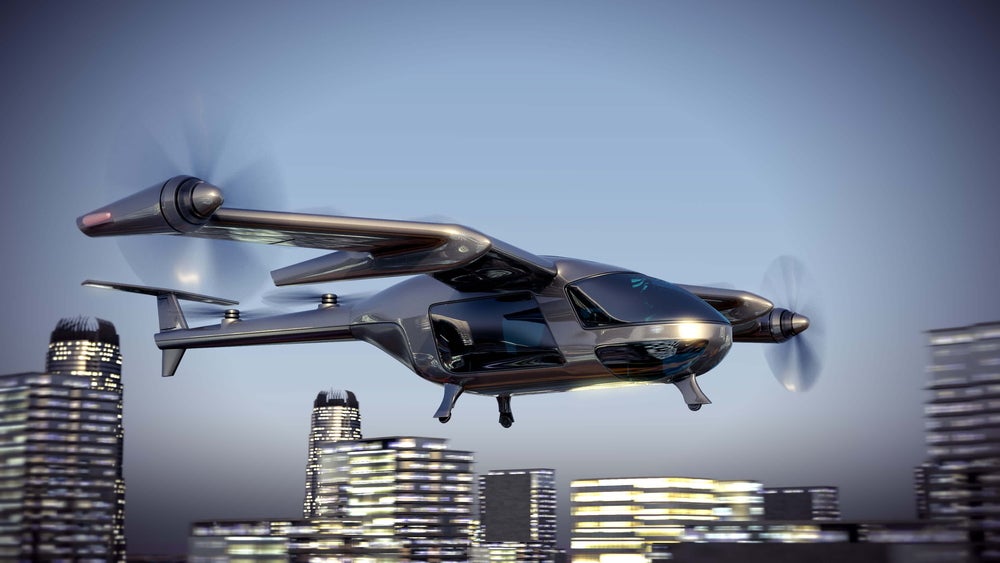Over the past five years, urban air mobility (UAM) solutions — vehicles that combine the capabilities of an aircraft and a road vehicle — have transformed from mere science fiction into functional reality. This roadmap (or rather, flight path) of development has culminated in Capital A, a Malaysia-based provider of budget airlines, signing a lease for at least 100 electric vertical take-off-and-landing (eVTOL) aircraft. This comment by Emilio Campa, Associate Analyst for GlobalData’s Thematic Team.
By 2025, you and three friends could be flown by a qualified pilot in these aircraft from a landing pad in central Kuala Lumpur to the city’s international airport at a top speed of 202 mph (325 kmph), all for less than $50 per person. However, there is still a long way to go before an air taxi ride takes off as a viable alternative for the average commuter.
Capital A’s eVTOL
Back in February 2022, Capital A signed a lease with Avolon, a leasing company based in Ireland, for at least 100 VX4 aircraft from British developer Vertical Aerospace. “Our aim is very clear – to have [VX4s] fly all over Southeast Asia,” said Capital A CEO Tony Fernandes.
The development of UAM solutions has been supported in part by developments in batteries and lightweight materials, and the VX4s are a good example of that. The aircraft have a zero-carbon footprint thanks to an electric engine co-developed with Rolls Royce. They are also made of a lightweight carbon fiber composite, reducing the amount of power needed to get them off the ground.
Is the hype around flying taxis justified? It is certainly the case that more attention is being paid to UAM solutions. According to GlobalData, venture capital investments in the UAM solutions space grew from $76m in 2015 to $2.1bn in 2021. Big names from multiple sectors are also getting involved in some capacity — including Boeing, Uber, Intel, and Hyundai.
Governments in various other countries have also been encouraging the development of UAM solutions. For instance, in April 2021, Russia announced that it would launch a full-fledged UAM solution named Cyclocar by 2022. In August 2020, the Japanese government announced a proposal to launch private flying vehicles by 2023.
How well do you really know your competitors?
Access the most comprehensive Company Profiles on the market, powered by GlobalData. Save hours of research. Gain competitive edge.

Thank you!
Your download email will arrive shortly
Not ready to buy yet? Download a free sample
We are confident about the unique quality of our Company Profiles. However, we want you to make the most beneficial decision for your business, so we offer a free sample that you can download by submitting the below form
By GlobalDataHowever, existing transport regulations do not yet extend to flying over a city at an incredibly low altitude. According to NASA, regulations that allow for scalable UAM operations will not be widely introduced for at least another 10 years. Companies are actively engaged with regulators to speed up the process, but safety concerns mean that progress is slow. Manufacturers will have to prove they can address any difficulties with operating the aircraft and ensure safety during adverse weather conditions for regulators to be satisfied.
Will battery supplies stop flying taxis from taking off? With increasing pressure from governments worldwide to phase out combustion-powered vehicles, future UAM solutions will have to rely on batteries for power. Demand for batteries is expected to accelerate dramatically as the automotive industry makes a similar move to battery electric vehicles.
Demand is beginning to outstrip supply, especially in some of the key raw materials such as lithium, cobalt and nickel. With these shortages ahead, it is not clear whether eVTOLs will be the first customers in this queue. Although flying taxis are certainly becoming more of a reality, regulatory and macroeconomic challenges mean getting them off the ground may take a while.
Mobility services set to take off in post-pandemic society
ATI Introduces Hydrogen-Powered Midsize Aircraft for Zero-Emission Flight









Related Company Profiles
The Boeing Co
Intel Corp
Rolls-Royce Holdings Plc
Capital A Bhd